Masonry Saws
Masonry Saws: Weathering the Challenges of Time
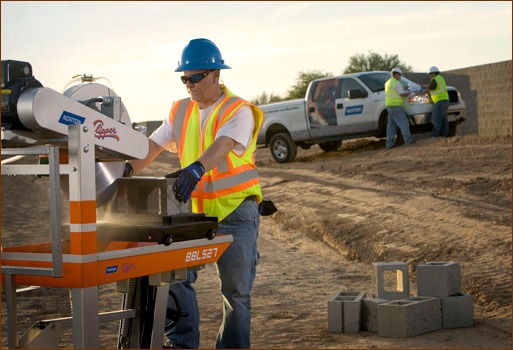
Like the masonry craft, some tools of the trade continue to play a vital behind-the-scenes role in today’s building architecture.
Take for instance the masonry saw. For someone outside the masonry industry looking in, he would be unaware of the critical role a masonry saw plays. Most would even go as far to say how simple of a tool it appears. And, if one viewed a photo of a saw from years ago to one today, a person might consider these saws somewhat archaic with few changes. But, that comment would be the farthest from the truth. Masonry saws have adapted well over time to meet the needs of masons and the challenges they face.
For us at Norton Clipper, we started our business in 1937 as Clipper Manufacturing Co., with our first masonry saw that set a new standard for production when compared to the actual “clipper” mason who used a hammer and chisel.
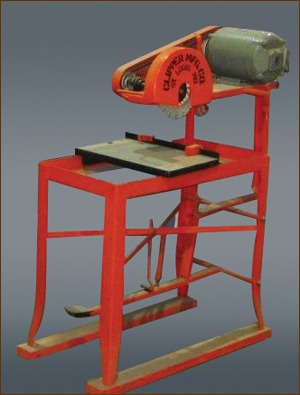 |
|
| Shown is one of the first saws that came off Clipper Manufacturing Co.’s assembly line in 1937. |
During the last 73 years, the basic design of masonry saws may not have changed much, but the features certainly have. One key area would be the blade guard. In the beginning, the front was open by as much as three inches, to nearly the 10-o’clock position from the bottom front. This was done so the operator could cut a block down to the table. The problem was that it exposed the mason to the diamond blade with little regard for safety. The introduction of the “stay level” blade guard feature keeps the guard parallel to the cutting table allowing the same cut, protecting the operator and increasing the accuracy of the cuts being made.
The shape of earlier blade guards was square or octagonal. Cutting slurry would build up in the corners of the guards, eventually leading to corrosion. This build-up had a slope configuration when viewed. Norton Clipper redesigned the shape to a teardrop, allowing slurry to keep moving out of the way from the blade and saw. To this day, it’s Norton’s signature mark. Also the water distribution, on early models, was positioned to the front of the guard to keep the water on the cut. The problem was that if a smaller blade was used, the water placement was missed. A modification was made to move the water as close to the arbor as possible, providing better distribution. Both the guard shape and water placement increase the life of the blade, costing the user less over time.
As mentioned, basic frame designs today are similar to ones many years ago. Here is one that probably few consider: the water drain plug placement. We probably all can agree that the center of the pan provides one of the best places for drainage. But have you ever wondered why most saws today position that place to the back corner of the pan? Most people don’t. But, there is a least one reason to consider. Years ago, Norton’s product management team caught word of increased jobsite accidents with masons in the Northern states during the winter. What they found was that masons would cover the motor with a bucket to protect it, and then drain the pan to keep the water from freezing. The water on the ground would freeze, and the operator would come in the next day and slip on the frozen ice next to the saw. A simple fix was made by moving the drain plug to the corner, so a bucket could be set beneath the pan to catch the water. By having it in the corner, the bucket missed the adjustment bar of the foot pedal. Something so small to some, but as important to others as the blade guard change.
Being an operator, one can appreciate little things, like a sloped water pan. By sloping the front of the pan, it allows the operator to get closer to the foot pedal and table, while pushing it through. The additional room the slope gives also helps keep the operator from hitting his knee against the table when the pedal comes back up, and affords a more comfortable operating zone with reduced fatigue.
Frames have changed further to an open back that provides the mason the ability to push bigger materials all the way through for “pass through rip cutting,” versus the closed back that required a shorter cut, flip and cut other end. It’s a great time saver with a more accurate, straight cut.
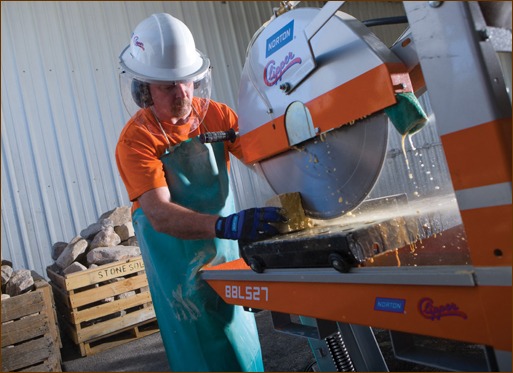
But, no matter what type of saw you operate today, basic maintenance is critical to the life of any tool. You can go from the simple – belts may need adjusting and the motor or engine general cleaning and oil changes, to the more intense of blade shaft pulleys and water pump that require much more. Your owner’s manual is ideal for review on this subject to avoid potential costly downtime.
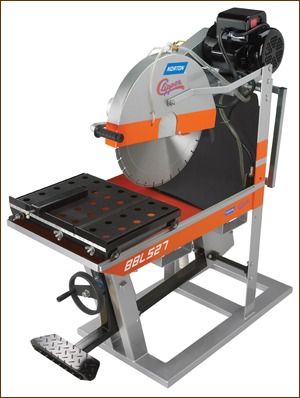 |
|
| Norton’s BBL527 |
Norton recently ran a promotion to get a feel for what ages of saws were still in the market. Some of the entrants had saws as old as 60-plus years, and still in routine operation. It clearly demonstrated that masons take pride in their tools, and that basic maintenance combined with a good, quality saw stand the test of time.
Today, we see more high-speed cut-off saws on jobsites. And, they, indeed, have their place. The value of a masonry saw – less operator fatigue, more precise cuts, continuous productivity, and, most important, improved safety – makes it hard to replace as a stationary saw on any jobsite.
It’s the rich history and remarkable usability and simplicity of the masonry saw that elevates it from potential dinosaur status to solid benchmark of today, able to weather many climate changes and provide performance, durability and dependability.
| Product Watch |
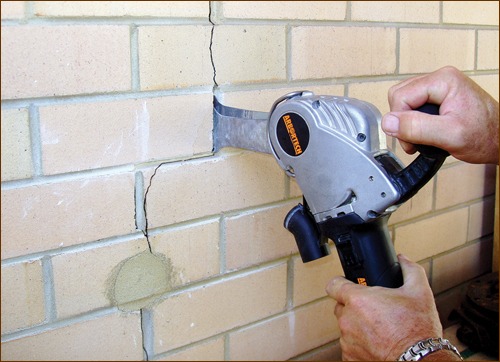
Arbortech’s AS170 brick and mortar saw offers extreme levels of precision, accuracy and control, and safety. Its patented Allsaw cutting technology uses an orbital cutting motion with two forward facing blades that combine to perform both a hammering and a cutting action that allows for the user to have clear visibility and the ability to accurately cut square and deep. Weighing 9.5 pounds, the AS170 saw has a cutting depth of 4-3/4 inches and a cutting width of 1/4 inch. The saw features a powerful, 13-amp motor constructed with a dust-resistant, heavy-duty design to ensure long motor life in the toughest environments. The AS170 generates little flydust, protecting the operator and creating a cleaner and safer environment. The unique design of the saw prevents kickback and is easy to control, which provides additional operator safety. In addition to brick and mortar, the AS170 can be used to cut fiber cement, fast block, soft sandstone, natural limestone, softer stone, hardwood, chip or plywood, tree roots in the ground, foam, PVC, acrylic and fiberglass sheet. The AS170 saw is available with four different blades including a general-purpose blade, a plunge blade, tuckpointing blade and switch box blade. The blades feature resharpenable tungsten carbide teeth for longevity. The saw comes with a heavy duty tool bag to transport it to and from the jobsite, and two accessories, a vacuum attachment and blade sharpening disk. For more information and to view a demonstration of the AS170 brick and mortar saw in action, visit www.AS170.com. |